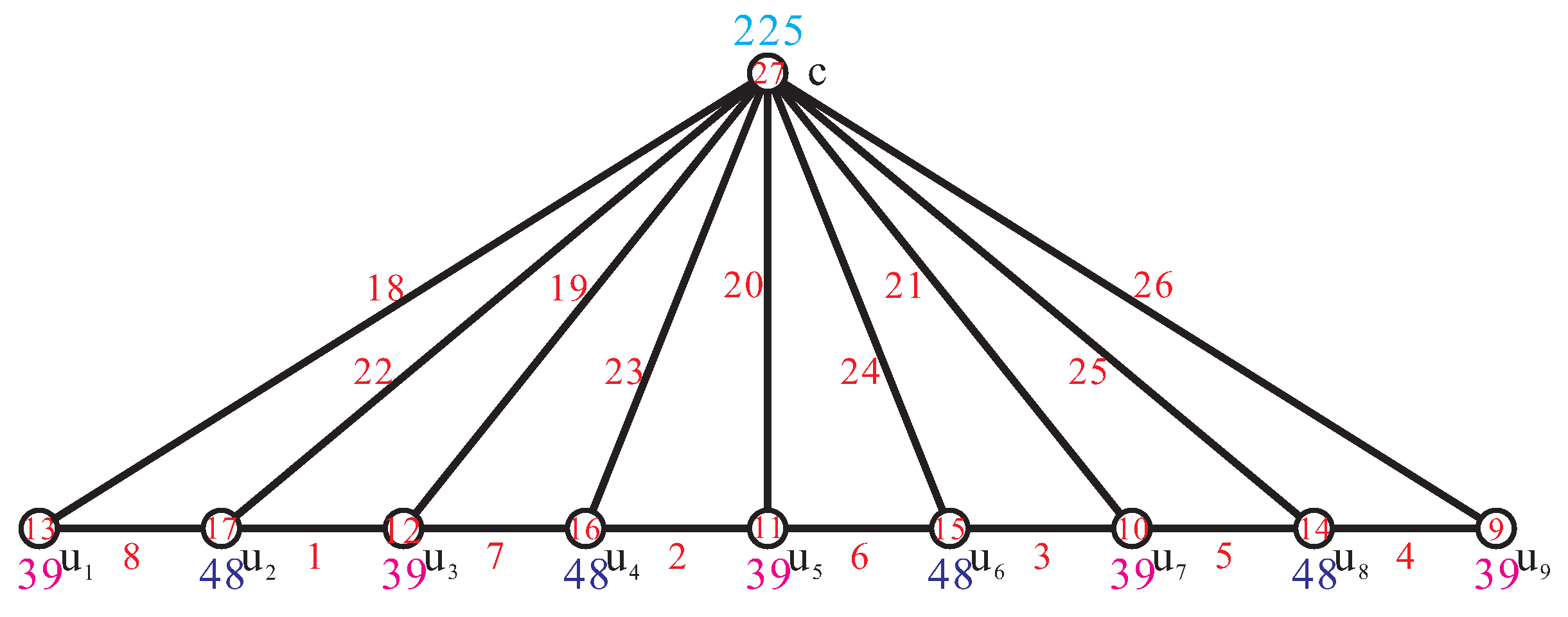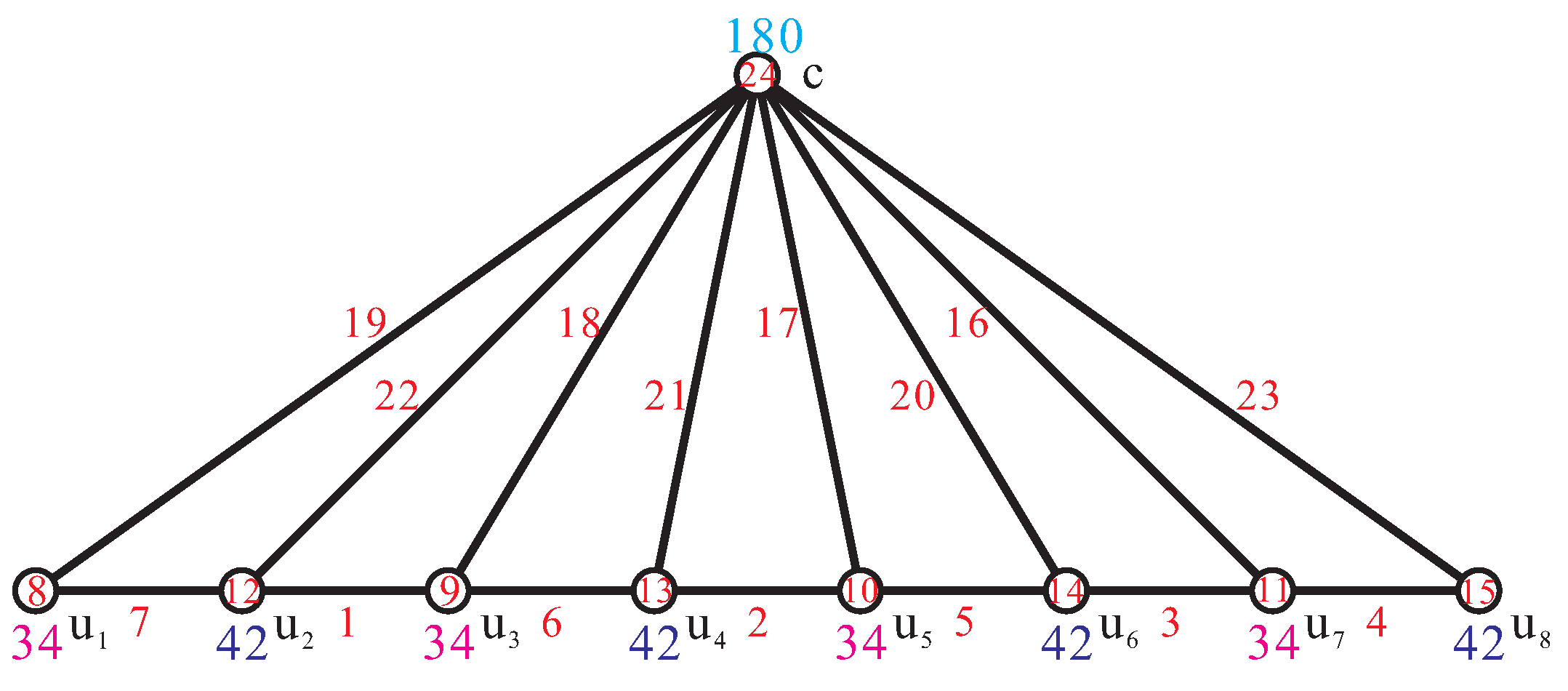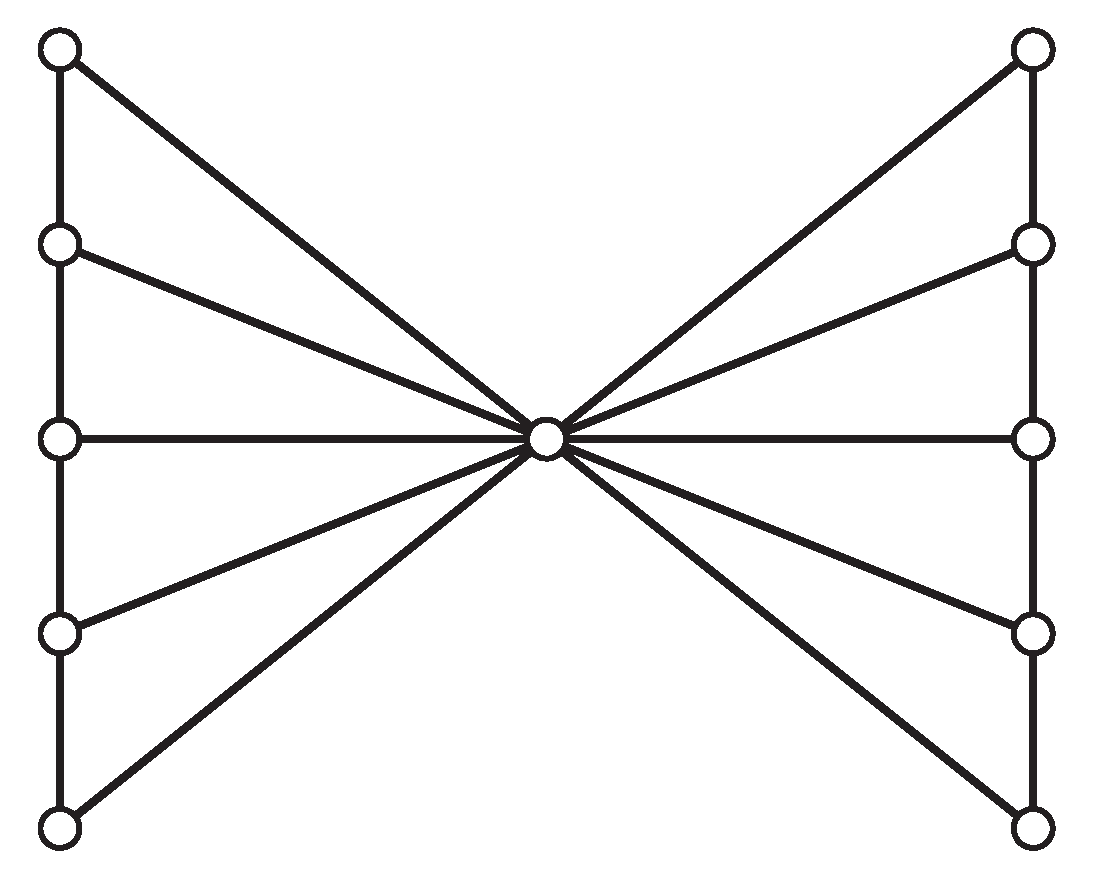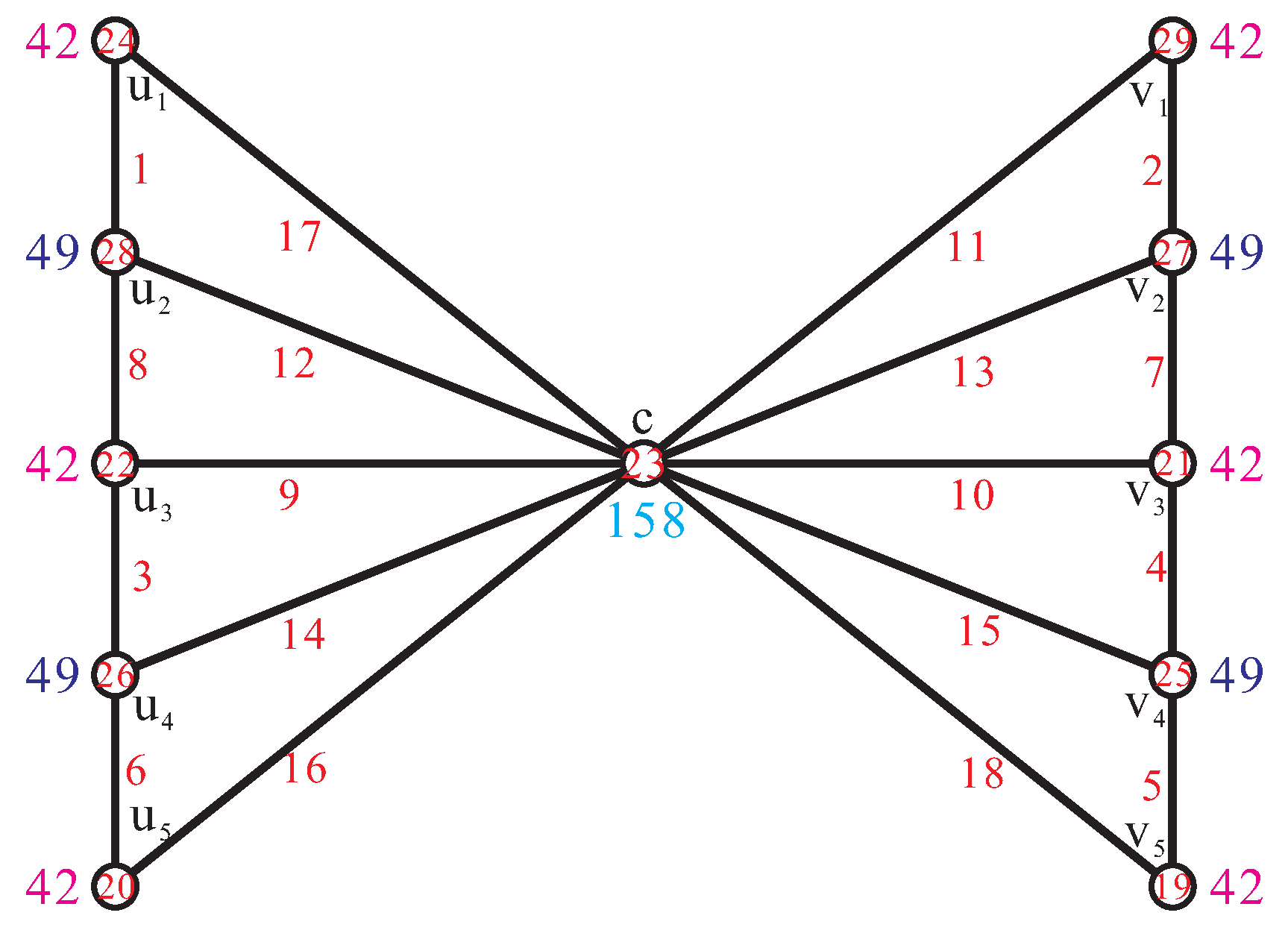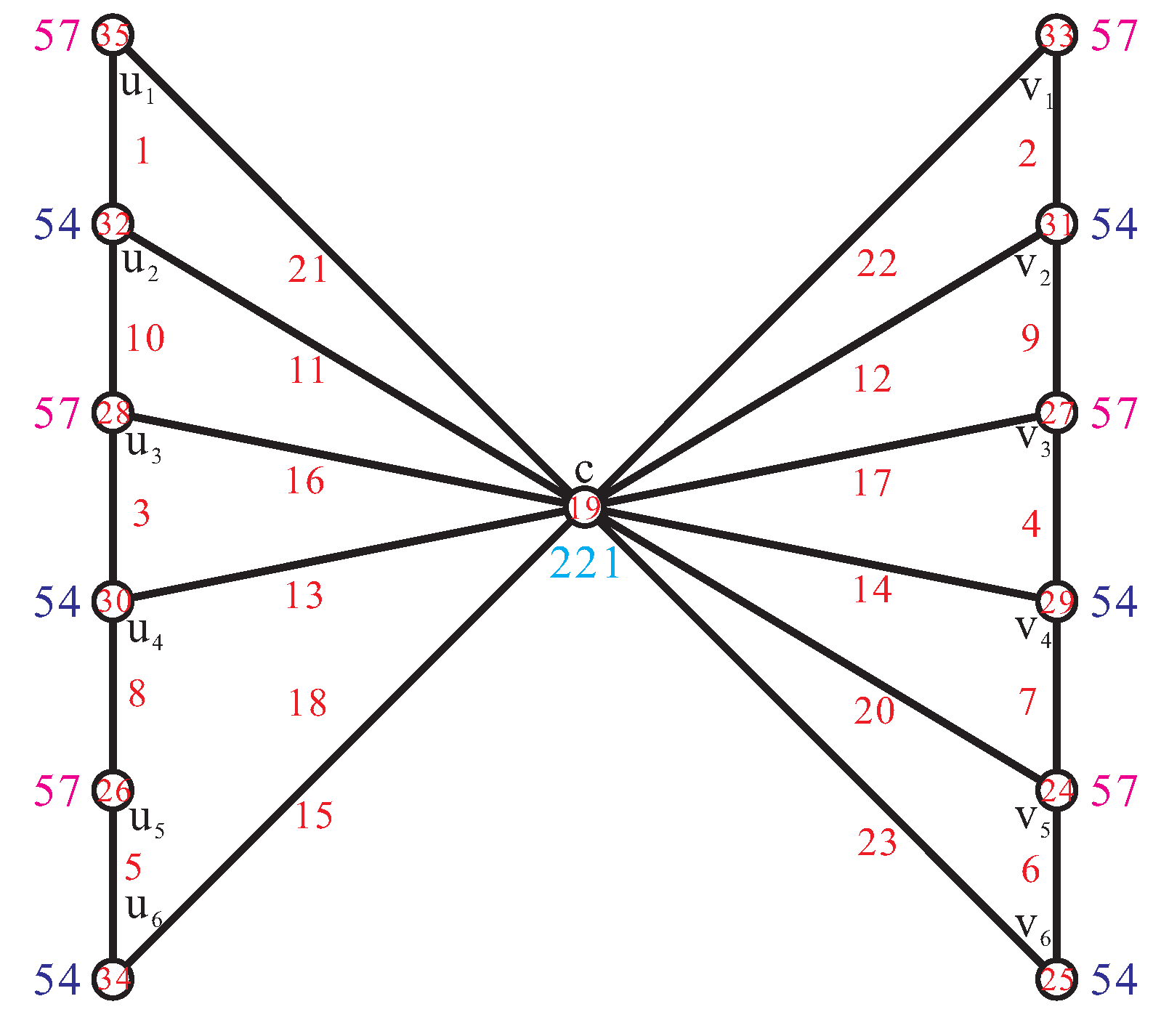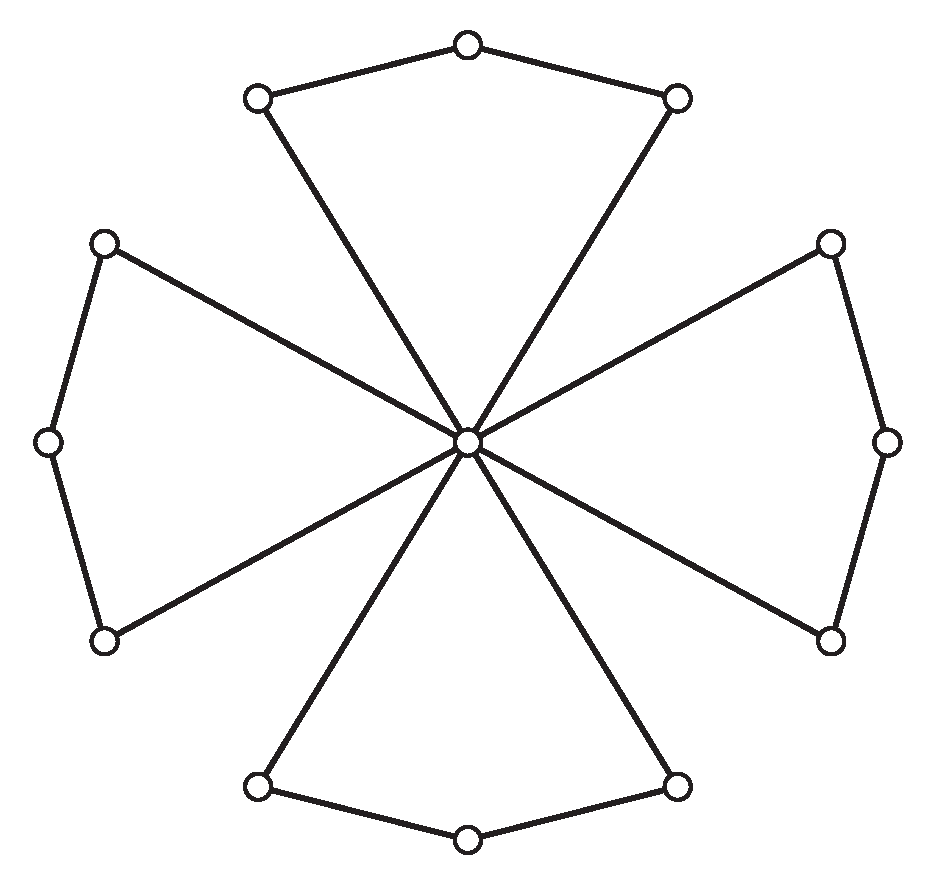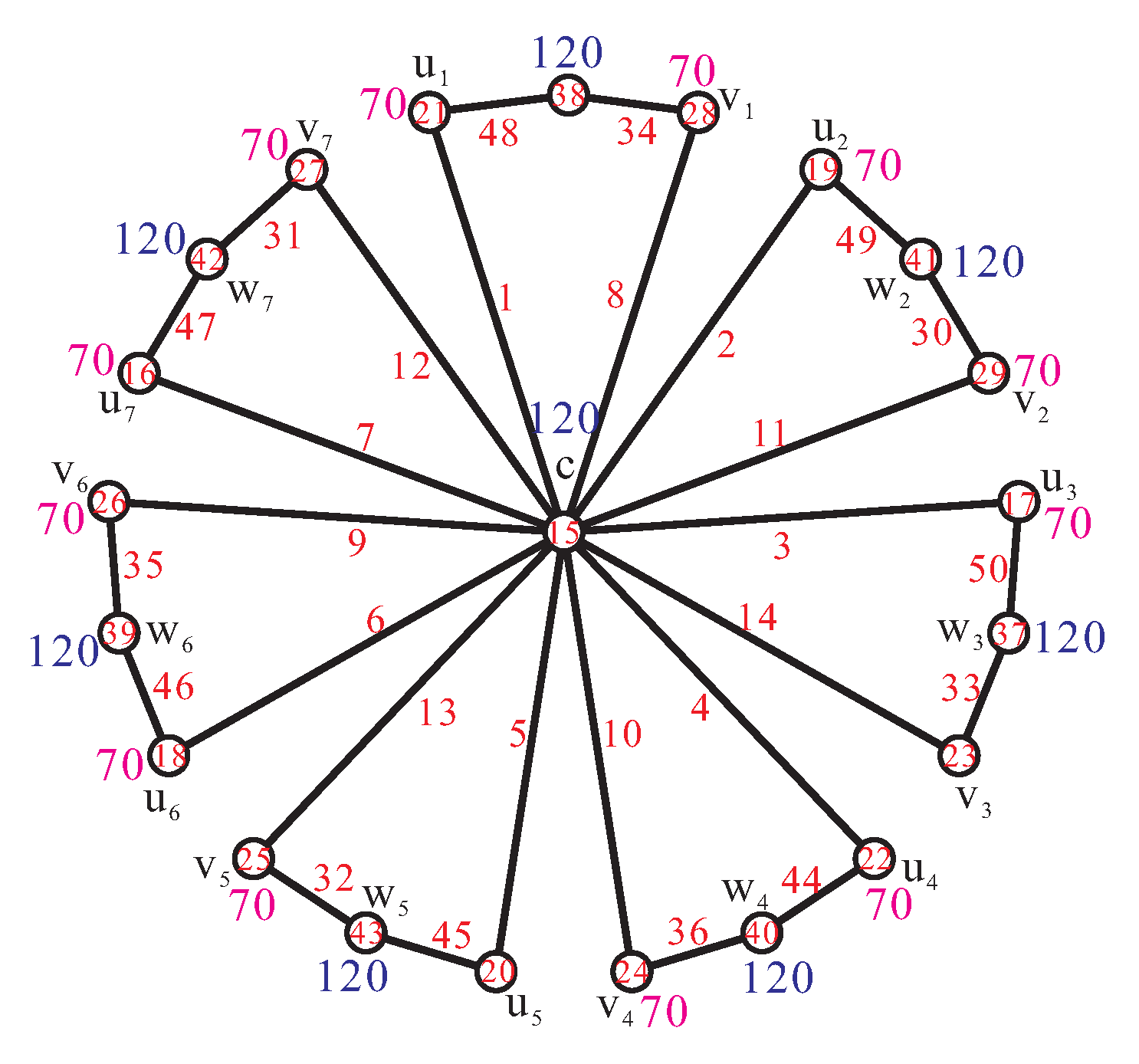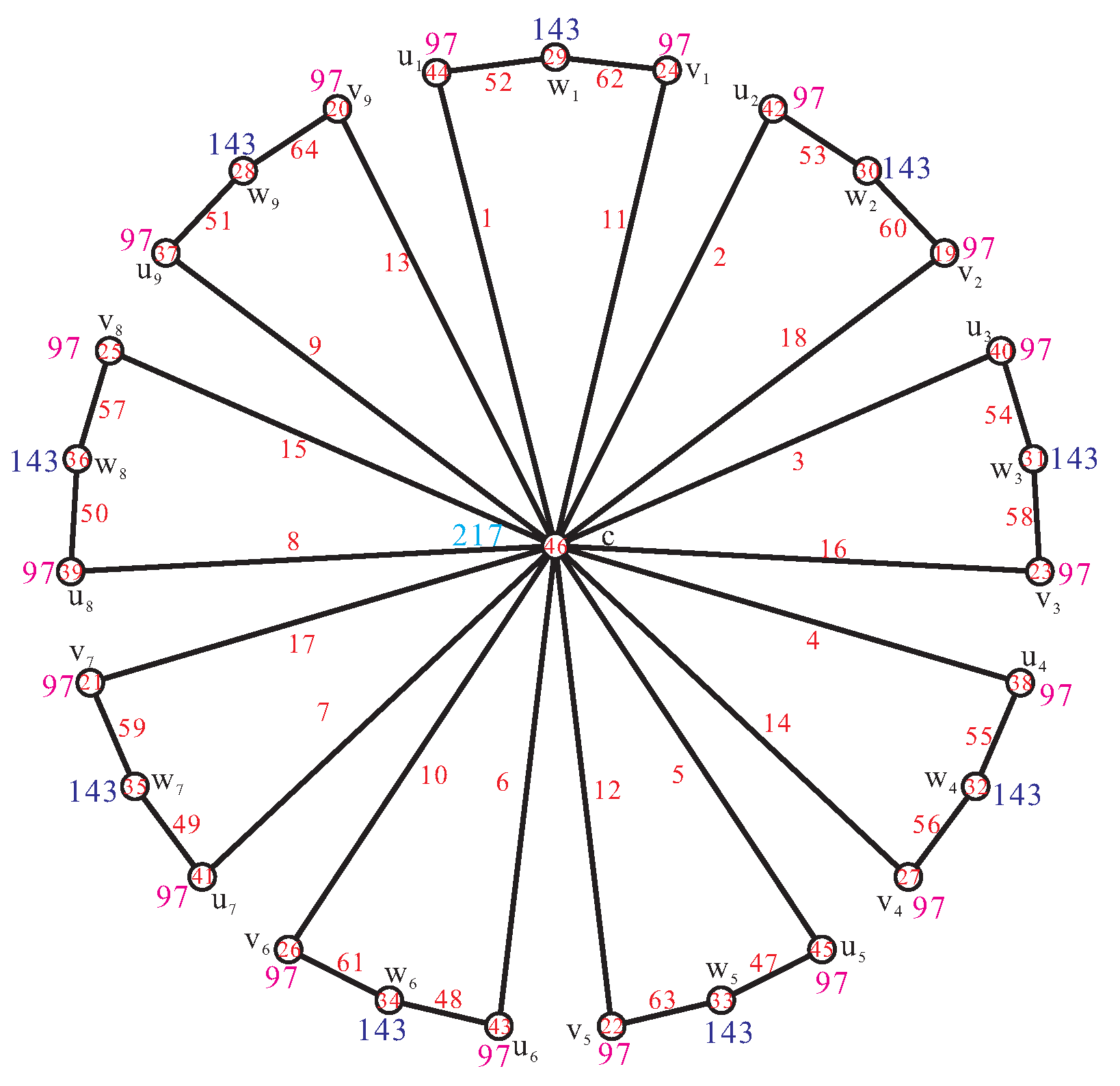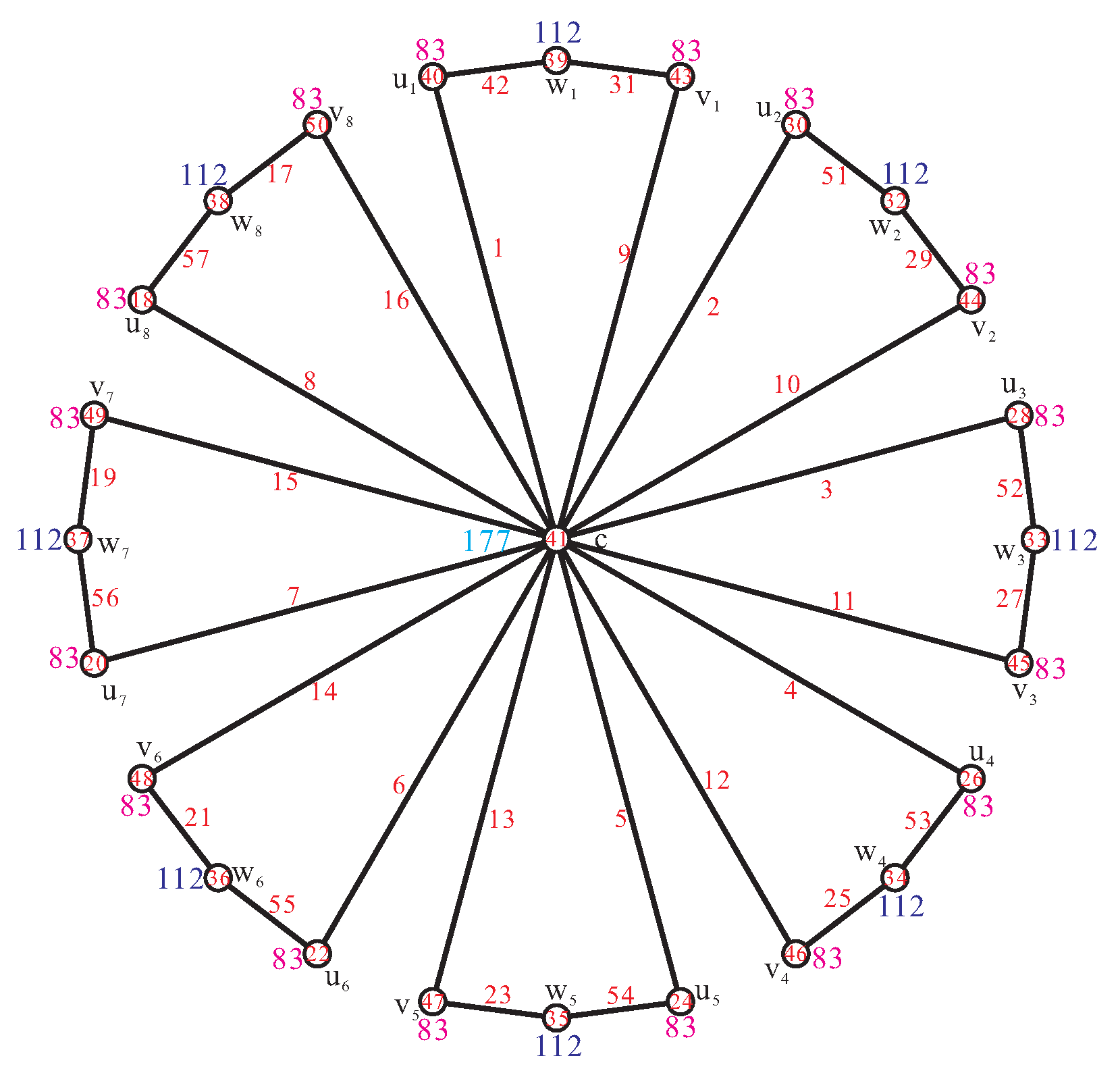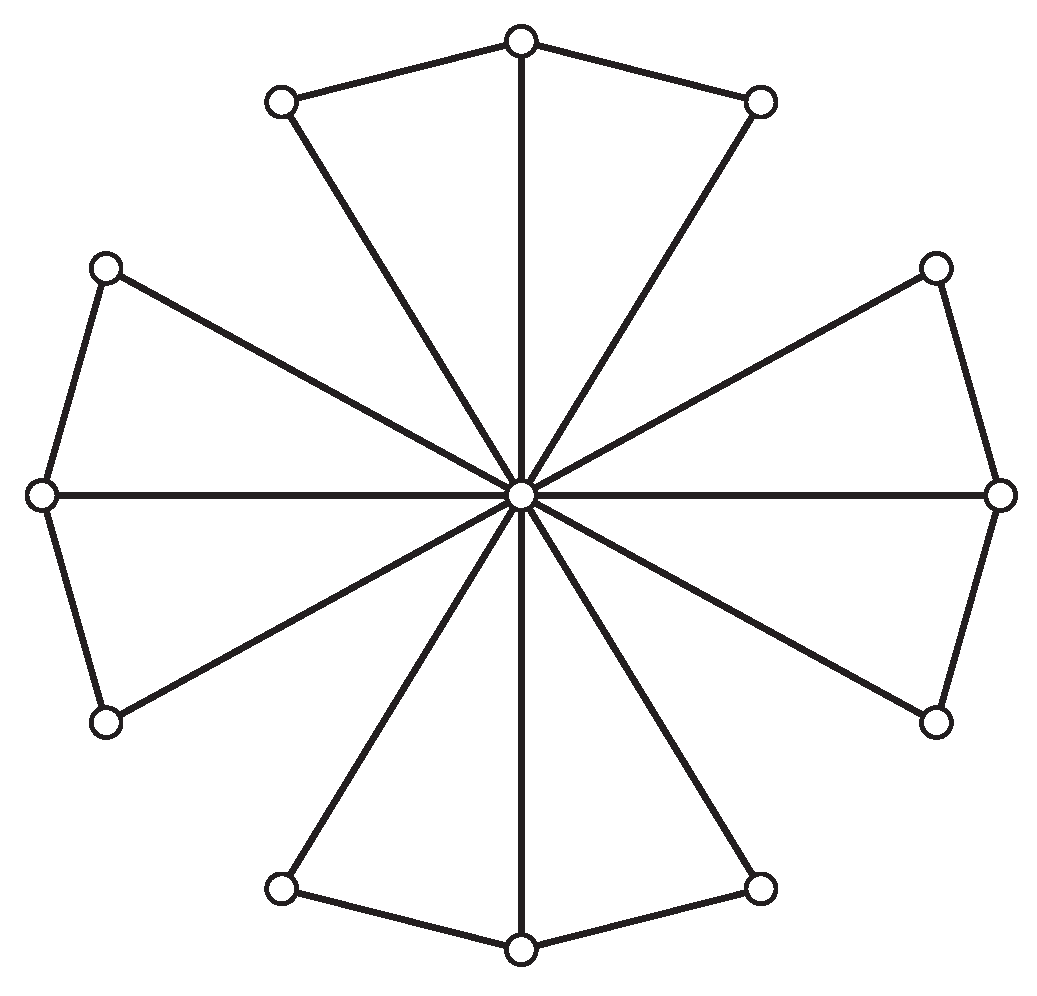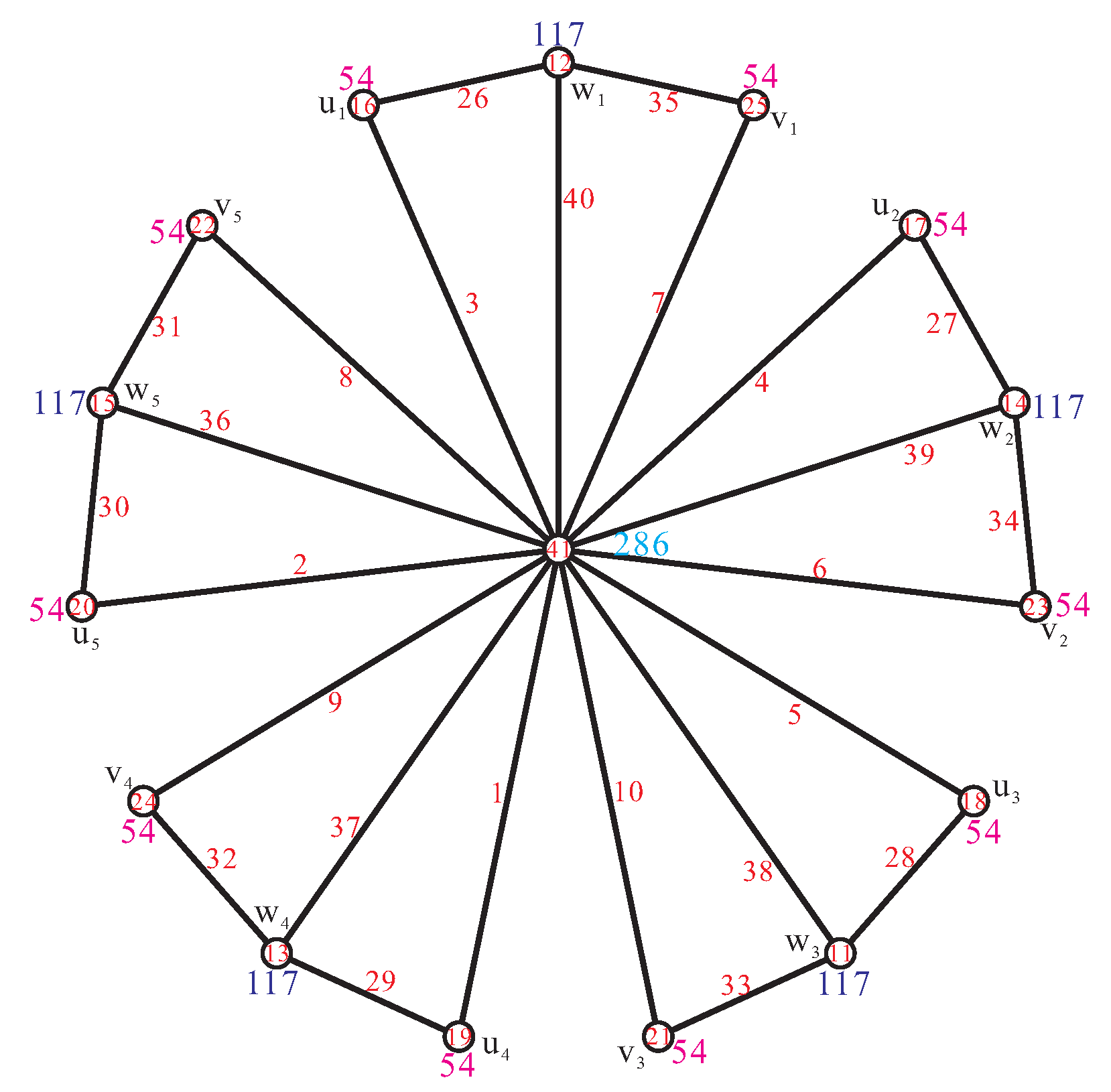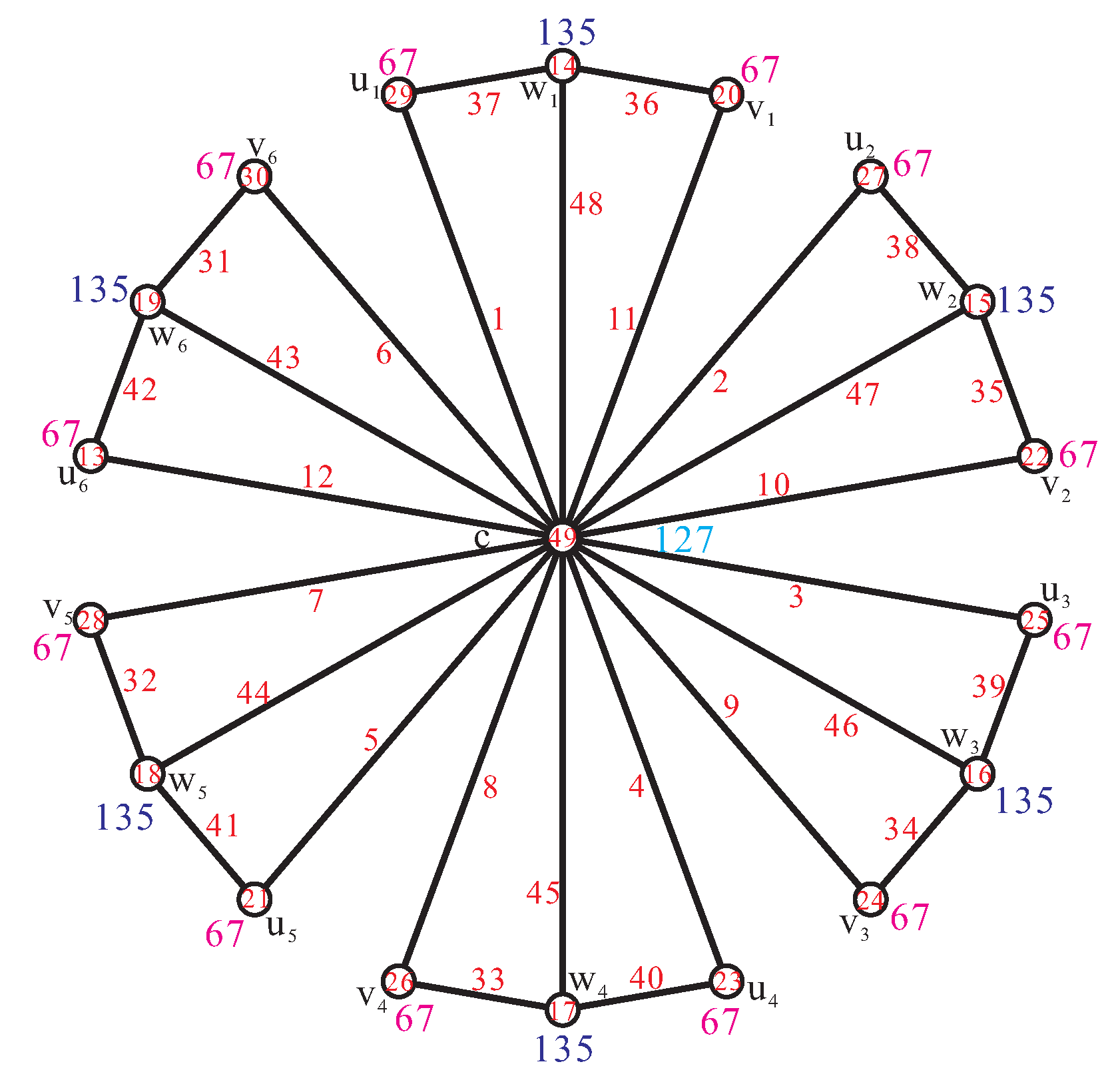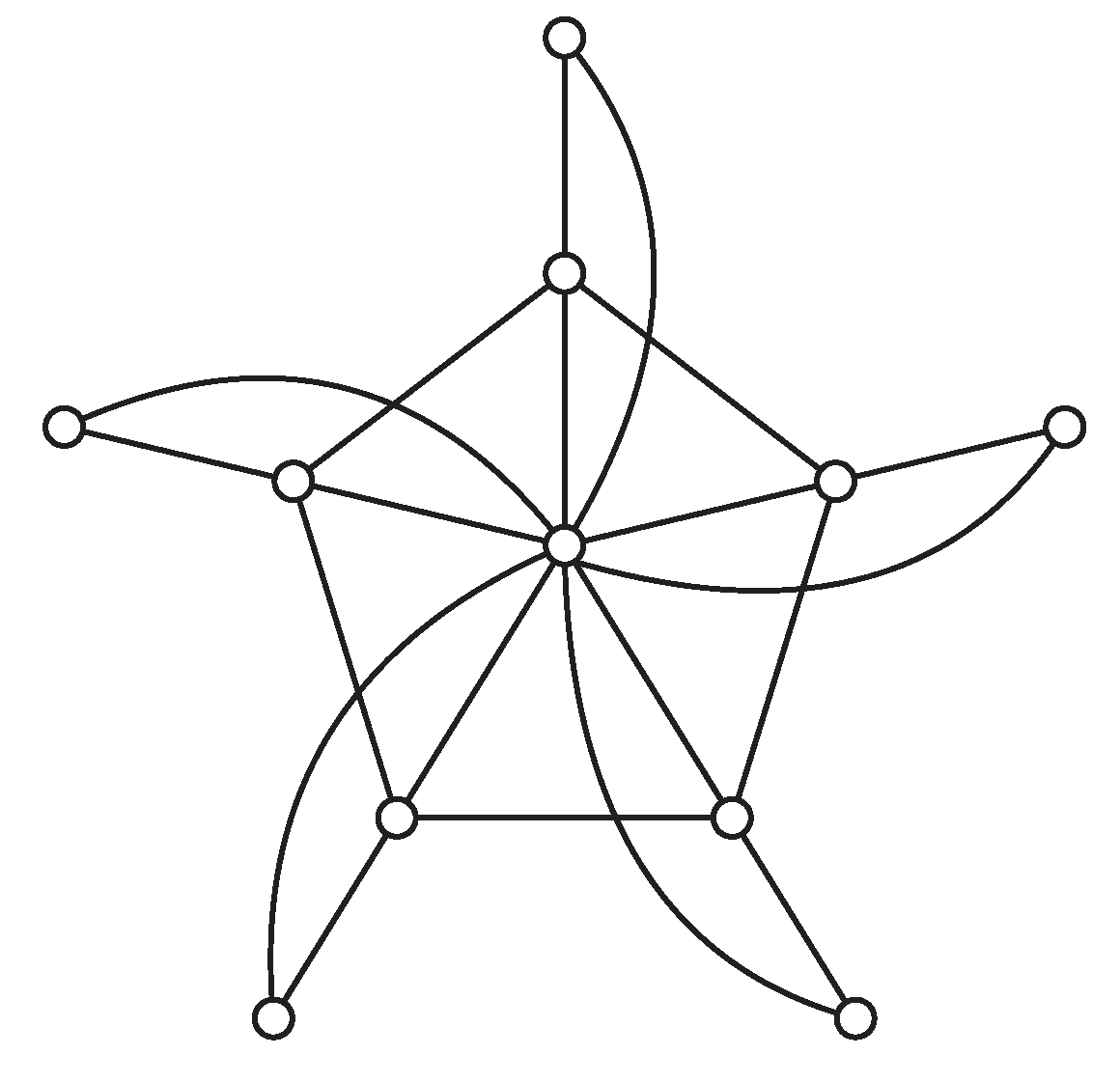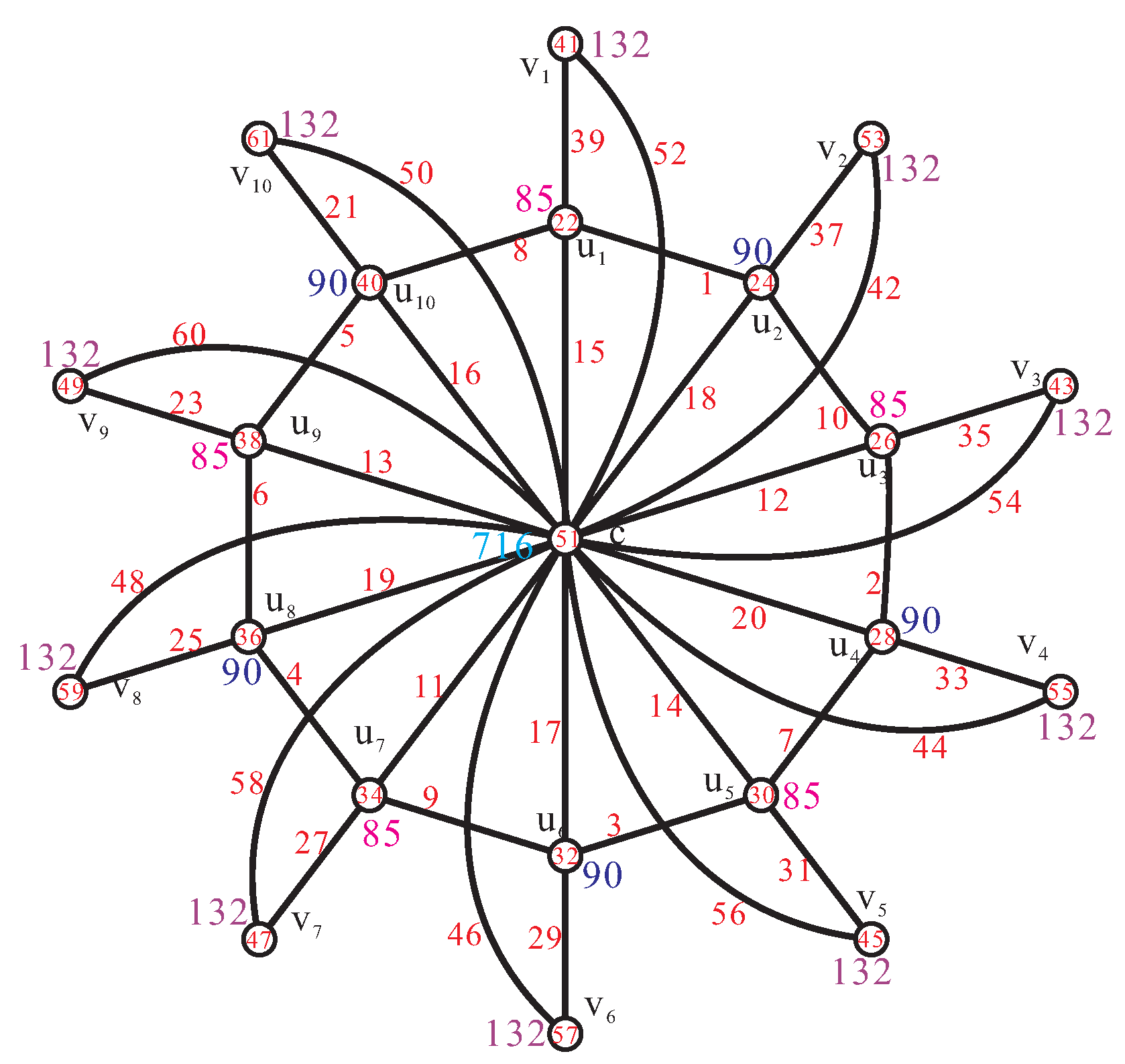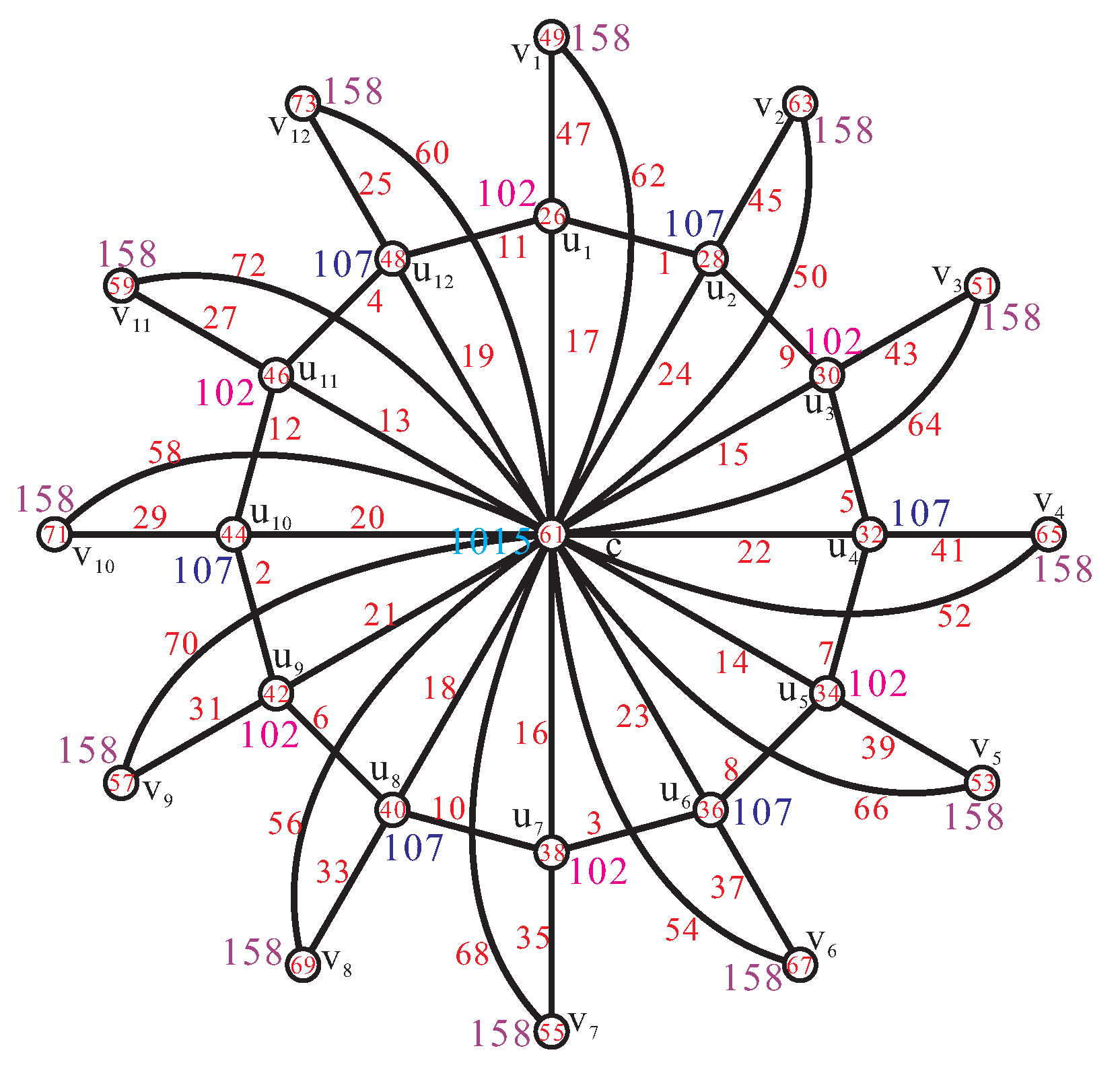1. Introduction
Let
be a connected simple graph with
n vertices and
m edges. In 2017, Arumugam et al. [
1] and Bensmail et al. [
2] independently introduced the notation of local antimagic labeling of graphs. A bijection
is called a
local antimagic labeling of
G if any two adjacent vertices
u and
v in
G satisfy
, where
, and
is the set of edges incident to
u. It is clear that assigning
to
x for each
naturally induces a proper vertex coloring of
G, which is called a local antimagic coloring of
G. A graph
G is called local antimagic if
G has a local antimagic labeling. The
local antimagic chromatic number [
1] of
G, denoted by
, is the minimum number of colors taken over all colorings of
G induced by local antimagic labelings of
G.
Arumugam et al. [
1] presented the local antimagic chromatic numbers of some families of graphs, such as star
, path
, cycle
, wheel
, friendship graph
, complete graph
, complete bipartite graph
and the join graph
, where
G is a graph of order
and
is the complement graph of the complete graph
. Meanwhile, many researchers have studied the local antimagic chromatic numbers of classes of many graphs. In [
3], Lau et al. gave counterexamples to the lower bound of
that was obtained in [
1]. Another counterexample was independently found by Shaebani [
4]. Lau et al. gave affirmative solutions on Problem 3.3 of [
1] and settled Theorem 2.15 of [
1]. Moreover, they also completely determined the local antimagic chromatic number of a complete bipartite graph. In [
5], Lau et al. presented some sufficient conditions for
, where
H is obtained from
G by deleting or adding a certain edge. They then determined the exact values of the local antimagic chromatic numbers of many cycle-related join graphs. Nazula et al. [
6] determined the local antimagic chromatic number of unicyclic graphs. Premalatha et al. [
7] determined the local antimagic chromatic number of the corona product of two graphs, such as paths with null graphs. In [
8], Bača et al. estimated that for the bounds of the local antimagic chromatic number for disjoint union of multiple copies of a graph, there are trees and graphs with vertices of even degrees and with chromatic index 3. From the results proved by Haslegrave [
9], Bača et al. obtained that the local antimagic chromatic numbers of disjoint union of arbitrary graphs are finite if and only if none of these graphs contain an isolated edge as a subgraph.
Recently, Putri et al. [
10] extended this notion by labeling the vertices and edges of a graph
G to establish a vertex coloring. The
local antimagic total labeling on a graph
G is defined to be an assignment
so that the weights of any two adjacent vertices
u and
v are distinct, that is,
, where
. Analogous to the local antimagic labeling, any local antimagic total labeling induces a proper vertex coloring of
G, where the vertex
x in
G is assigned the color
. The
local antimagic total chromatic number of
G, denoted by
, is the minimum number of colors taken over all colorings induced by local antimagic total labelings of
G. Clearly,
for any graph
G. Putri et al. [
10] presented the local antimagic total chromatic numbers of some families tree, such as star, double star, banana tree graph, centipede graph, and the amalgamation of the star graph. In [
11], Kurniawati et al. determined the exact values of local antimagic total chromatic numbers of graphs
, when
G is the star, path, cycle and friendship graphs. Moreover, Kurniawati et al. [
12] determined the exact value of graphs
, when
G is the star, path, cycle and friendship graphs.
In this paper, we present the local antimagic total chromatic numbers of some wheel-related graphs, such as the fan graph , the bowknot graph , the Dutch windmill graph , the analogous Dutch windmill graph and the flower graph .
2. Main Results
In this section, we compute the local antimagic total chromatic numbers of some wheel-related graphs. In [
1], Arumugam et al. presented the exact value of
with three cases: (i)
for
, (ii)
for
and (iii)
for
. However, they only presented the range of
for
. Then Lau et al. [
3] gave the exact value of
that
for
. In [
5], Lau et al. corrected three errors of the local antimagic labeling for
and one error of the local antimagic labeling for
. Arumugam et al. and Lau et al. completely determined the exact value of the local antimagic chromatic number of the wheel in the following lemma.
Lemma 1 ([
1,
3])
. For the wheel of order , we have Lemma 2 ([
10])
. For any graph G, we have . The fan graph
of order
is obtained by deleting a rim edge of the wheel
, where the central vertex of
is also the central vertex of
. The fan graph
is shown in
Figure 1. In fact, Slamin et al. [
13] in 2018 and Amalia et al. [
14] in 2021 presented the exact value of the local antimagic total chromatic number of the fan graph. However, the following local antimagic total labeling of the fan graph in Theorem 1 is different from that of these authors.
Theorem 1. For the fan graph and , then .
Proof. Let
and
be vertex set and edge set of the fan graph, respectively. Then we obtain
and
. It is clear that
. In order to prove that
, it suffices to prove that
, which means that we should obtain a local antimagic total labeling using three distinct colors. Define
. Let
, and label the edges
for
i such that
as follows:
Then label the remaining edges and vertices of graph . Let us discuss two cases for n.
From the above labelings, we have
Thus f is a local antimagic total labeling using three colors, and we obtain .
From the above labelings, we have
Thus f is a local antimagic total labeling using three colors, and we obtain . The proof is complete. □
All figures in this paper, the red front represents the local antimagic total labeling of edges and vertices of graph; other colors represent the sum of weights of vertex and the edges incident with the vertex in the local antimagic total labeling of graphs. Different colors are selected to clearly see the number of different colors of vertices in the figure.
Example 1. The local antimagic total labelings of the fan graph and are shown in Figure 2 and Figure 3. The bowknot graph, denoted by , is the graph by gluing two central vertices of double fan graphs . Obviously, the bowknot graph is obtained from the wheel by deleting two edges every edges on the rim of the wheel, and shown in Figure 4. It has vertices and edges. Theorem 2. For the bowknot graph , we have .
Proof. Let be the vertex set of graph , and let be the edge set of . Since is an induced subgraph of , we have . Define and consider the following two cases.
Case 1. If n is odd.
Firstly, label the edges of
as follows:
Secondly, label the vertices of
by the following way:
It is clear that f is a local antimagic total labeling of using three distinct colors and for odd n.
Case 2. If n is even.
Label the edges of
as follows:
Then, give the exact values of the vertices of
:
From above labelings under
f, we obtain
Clearly, f is a local antimagic total labeling of using three distinct colors and . Hence, we obtain for , and the proof is completed. □
Example 2. Let and . We have the local antimagic total labelings of the bowknot graph and in Figure 5 and Figure 6. The Dutch windmill graph, denoted by , is a graph of order and size by gluing a common vertex of n cycles . A example of the Dutch windmill graph is shown in Figure 7. Note that the Dutch windmill graph is obtained from the wheel by deleting one edge continuously every 2 edges on the rim of the wheel , and then delete the middle spoke edge of each vane in the resulting graph. Let and be the vertex and edge sets of graph , respectively. Theorem 3. For the Dutch windmill graph , we have Proof. Obviously, the lower bound of the local antiamgic total chromatic number for graph is two since . Then we consider the upper bound of .
Define . Let be the sum of the weights of the vertex c and the edges incident with the vertex c and let be the sum of the weights of the vertices for . If we use the minimum weights, label the vertex c and the edges incident with the vertex c, then , and if we use the maximum weights, label the edges and the vertices for , then . Suppose that there is a local antiamgic total labeling using two distinct colors labeling the graph ; thus, the color of the vertex c is same as the vertices for . It means and so . When , there possibly is obtained a local antimagic total labeling f using two distinct colors such that the vertex c and the vertices have the same color for . However, when , there must exist three different colors. Consider two cases as follows:
Case 1. For .
According to the parity of n, there are two subcases to confirm the exact values of the local antimagic total labeling.
Subcase 1. If n is odd.
Label the edges and vertices of the graph
by the following way:
From the above vertex weights, we have
Therefore, f is a local antimagic total labeling of the graph using three distinct colors and so for odd n.
Subcase 2. If n is even.
Label the edges and vertices of the graph
by the following way:
For the vertex weights under the labeling
f, we have
The above arguments indicate that f is a local antimagic total labeling of with three colors, and so for even n.
Case 2. For .
Present the detailed local antimagic total labeling for each
n when
. The following figure is shown the local antimagic total labeling for
in
Figure 8.
When , we obtain that and for . Similarly, when , we obtain that and for . When , we obtain that and for . Therefore .
When , and for . Similarly, when , and for . Therefore .
In conclusion, the local antimagic total chromatic number of the graph is for , and for , respectively. The proof is done. □
Example 3. The local antimagic total labelings of the graph and are shown in Figure 9 and Figure 10. The analogous Dutch windmill graph, denoted by
, is obtained from the Dutch windmill graph
by adding edges
for each
. The graph
has
vertices and
edges. It can be seen that the analogous Dutch windmill graph
can be viewed as from the wheel
by deleting one edge continuously every 2 edges on the rim of the wheel. The analogous Dutch windmill graph
is shown in
Figure 11.
Theorem 4. For the analogous Dutch windmill graph, , we have .
Proof. The lower bound of the local antimagic total chromatic number of graph is 3 since is an induced subgraph of graph and . Define . We discuss two cases for the exact value of each vertex and edge as follows.
Case 1. If n is odd.
For
, the local antimagic total labeling of the graph
is shown in
Figure 12.
Label the edges of
by the following way:
Then label the vertices of
as follows:
For the vertex weights under the labeling
f, we have
The above arguments indicate that f is a local antimagic labeling of with three colors, and so for odd n.
Case 2. If n is even.
We give the following exact values of edges of
:
Then label the vertices as follows:
It is clear that f is a local antimagic total labeling of using three colors and so for even n. The proof is complete. □
Example 4. The local antimagic total labelings of the graph and are shown in Figure 13 and Figure 14. The flower graph
of order
is a graph obtained by adjoining firstly a pendant edge to each vertex on the rim of the wheel graph
, then joining every pendant vertex to the central vertex of
by an edge. The flower graph
is shown in
Figure 15. Then we respectively obtain the lower and upper bounds of the local antimagic vertex total chromatic number of the flower graph
.
Theorem 5. For the flower graph , we have Proof. for odd n and for even n since is the induced subgraph of graph . Then give the upper bound of the local antimigic total chromatic number of the flower graph.
The flower graph has vertices and edges. The vertex set of is and the edge set of is , where the edge is the edge . Let f be the local antimagic labeling of the graph defined in Lemma 1 such that the vertices are assigned four distinct colors for odd n and three colors for even n.
Define a bijection . Firstly, label the edges of the subgraph of the such that , where . Secondly, label the remaining edges and vertices of using since the wheel has edges. Let us discuss two cases for n.
Case 1. If n is odd.
By Lemma 1, for
, the vertex weights of graph
are, respectively,
,
for odd
i and
,
for even
i and
. For
, the vertex weights of graph
are, respectively,
,
for odd
i and
,
for even
i and
. Then
Conclude the vertex weights under labeling g for each vertex of the graph as follows:
It is clear that g is a local antimagic total labeling of the graph using five colors, and so .
Case 2. If n is even.
By Lemma 1, for
, the vertex weights of graph
are, respectively,
for odd
i and
for even
i and
. For
, the vertex weights of graph
are, respectively,
for odd
i and
,
for even
i and
. Then
Accordingly, we obtain the vertex weights under labeling g for each vertex of the graph .
Therefore g is a local antimagic total labeling of graph with four colors and . The proof is done. □
Example 5. The local antimagic total labelings of the graph and are shown in Figure 16 and Figure 17. Example 6. The local antimagic total labelings of the graph and are shown in Figure 18 and Figure 19. 
